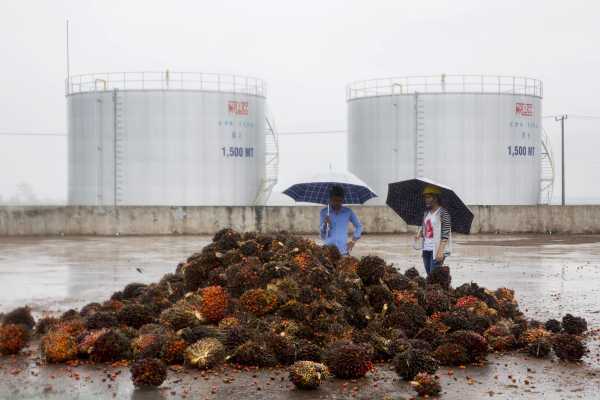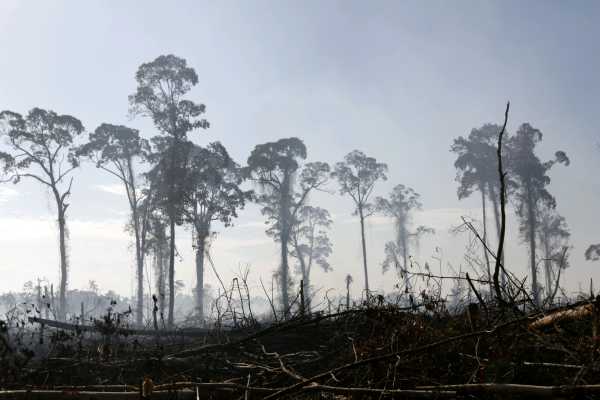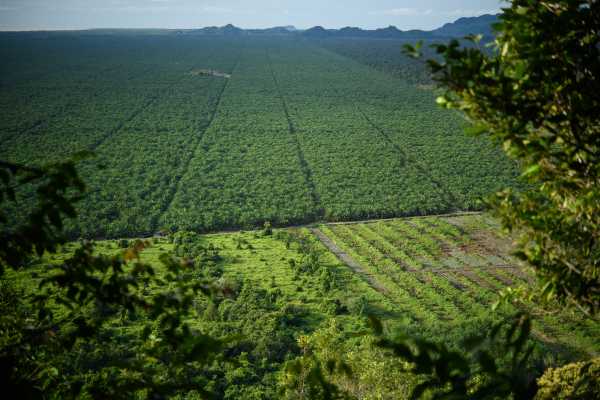
Benji Jones is a senior environmental reporter at Vox, covering biodiversity loss and climate change. Before joining Vox, he was a senior energy reporter at Insider. Benji previously worked as a wildlife researcher.
This story is part of a group of stories called

The biodiversity crisis, explained
Help our biodiversity reporting by taking our survey.
In the last two decades, palm oil has become an environmental boogeyman, an ingredient that conscious consumers should try to avoid.
The oil, found in everything from baby shampoo to ice cream, earned its bad reputation. Over the last 30 years, palm oil companies leveled acre upon acre of trees in Southeast Asia, which were full of life and carbon. The demand for this ingredient, now the world’s most common edible oil, undoubtedly has fueled two of the most urgent crises of our time: climate change and the loss of biodiversity.
But the story of palm oil is changing — seemingly for the better.
Over the last decade, the amount of deforestation caused by the industry has actually declined nearly every year in Indonesia, the world’s largest producer. And in 2021, it hit a 22-year low. Malaysia has seen a similarly positive trend, experts say, indicating that companies are now cutting down fewer trees.
“I don’t want to sit here and say that the palm oil industry has suddenly become shiny green and sustainable, but it’s mostly stopped deforestation,” said Glenn Hurowitz, the founder and CEO of Mighty Earth, an environmental advocacy group.

The industry has a horrific legacy, no doubt, and it’s still wrecking some forests in Southeast Asia and elsewhere. Yet it’s not the villain it once was.
This, of course, is good news for the wildlife of Southeast Asia, and for our climate. It’s also a reason to feel less guilty when indulging in doughnuts or creamy peanut butter. But more importantly, the story of palm oil may hold lessons for other industries that still stock our grocery stores with forest-flattening foods.
How palm oil destroyed the environment
Palm oil, which comes from the fruit of oil palm trees, is something of a super ingredient. It has little odor or color. It doesn’t spoil easily. It contains virtually no unhealthy trans fats. And it’s incredibly cheap to produce.
These characteristics helped palm oil rise to dominance, wrote journalist Paul Tullis, who called it “the world’s most versatile vegetable oil.”
In the ’90s, big food companies were looking to replace trans fats in their products like margarine; palm oil offered a solution, Tullis wrote. Around the same time, cosmetic companies wanted plant-based alternatives to synthetic and animal-based chemicals. This industry, too, saw promise in palm oil.

With help from governments and international banks, which saw palm oil as a way to alleviate poverty in parts of Asia, production skyrocketed. Nearly all of the growth was in Indonesia and Malaysia, partly because the climate is suitable and the government backed industrial-scale plantations. (The oil palm tree is native to West Africa).
Between 1995 and 2005, global palm oil production doubled. By 2015, it had almost doubled again. The world now produces more than 75 million metric tons of palm oil a year. For comparison, we produced roughly 3 million metric tons of olive oil in 2020. Palm oil and its derivatives are now in as many as half of the packaged products in supermarkets and 70 percent of cosmetics.
These staggering numbers came at a huge cost.
In the last two decades, Indonesia lost nearly 25 million acres of forest, an area larger than the entire country of Ireland. Roughly a third of that deforestation was caused by palm oil, according to a 2022 study. In Borneo, an island split among Brunei, Indonesia, and Malaysia, the palm oil industry caused roughly 40 percent of deforestation between 2000 and 2018, or roughly 6 million acres of forest loss. That’s almost five times the size of Delaware.
When the forests fall, so do hugely important ecosystems that influence the entire planet. The jungles of Indonesia and Malaysia are home to a stunning array of plants and animals including orangutans, tigers, and the world’s largest flower, the stinking corpse lily. Wet forests known as peatlands — many of which have been drained and replaced by plantations — also store massive amounts of carbon, which can escape into the atmosphere when they’re destroyed.

A rare successful campaign to make a product more sustainable
The destruction of forests didn’t go unnoticed. In the last two decades or so, advocacy groups like Greenpeace and Friends of the Earth published report after report linking palm oil in our everyday products to environmental harm.
These groups (and journalists!) helped out palm oil as dirty. And ultimately, that helped provoke change within the industry.
According to Mighty Earth’s Hurowitz, 2013 marked a turning point: Late that year, he and other advocates helped convince Wilmar — one of the world’s largest palm oil companies — to limit deforestation in its supply chain. The company didn’t need to clear forests to grow palm, Hurowitz argued, because there were plenty of already-degraded lands.
A year later, most other major palm oil companies had followed suit.
Other forces helped transform the industry, as well. A couple of years earlier, Indonesia stopped granting new permits for palm oil development in primary forests and peatlands, in part to reduce carbon emissions. In the last decade or so, technologies to monitor deforestation, such as through satellite imagery, have also improved dramatically, helping watchdogs hold palm oil companies accountable.
“We can now see deforestation in near-real time,” said David Gaveau, a landscape ecologist at TheTreeMap, a research organization, and lead author of the 2022 paper on palm-driven deforestation. “It’s not the Wild West it used to be.”

While it’s hard to say exactly which efforts were most effective, recent analyses suggest that at least some of them worked.
A study published in 2019 found that palm oil deforestation in Indonesia peaked in 2009, and then steadily declined — meaning, fewer trees were cut down — in the years that followed. Gaveau’s study found a similar trend: The conversion of forests to palm oil plantations has fallen every year between 2012 and 2019. Experts said Malaysia is following a similar trend.
Things are also looking good more recently. An analysis by TheTreeMap found that in 2021, deforestation linked to palm oil in Indonesia hit its lowest point in more than two decades (though it rose slightly in 2022).
So, is palm oil sustainable now?
No, not exactly.
Most palm oil in our products was grown on land that was once forest, and little of it has been restored back to its natural condition. “The palm oil industry has an enormous legacy of destruction that they have not addressed yet,” Hurowitz said. “We’ve had great success in stopping deforestation and not as much success and persuading the big palm oil companies to heal the damage.”
(Some groups are trying to restore old palm oil plantations to forest or make new plantations more environmentally friendly.)
And while deforestation tied to the industry is way down, companies are still razing forests for palm oil. Last year, roughly 47,000 acres of forests were cut down in Indonesia and replaced with palm oil plantations, according to TheTreeMap. That’s a little more than three times the size of Manhattan.
Some experts also worry that the drop in deforestation may have more to do with the price of palm oil — which started collapsing in 2011 — than with corporate or government policies. When oil is cheap, it often doesn’t pay to expand production.
This is concerning because the price of palm oil has, in the last few years, bounced back.
So far, however, the story remains positive, and the rise in palm oil prices has yet to drive a spike in forest loss. “The initial sign that [the] deforestation rate continues to be low suggests that we may be observing a decoupling of palm oil production from forest loss,” Kemen Austin, a palm oil expert and director of science at the Wildlife Conservation Society, said by email. In other words, growing palm oil production may no longer require cutting down trees. “We may still need another year or two to be able to quantify that with confidence, but its certainly a good sign,” she said.
There are other reasons to believe that deforestation related to palm oil will remain a success story. In December, the European Union agreed on a landmark law to prevent companies from selling palm oil and a handful of other commodities in the European Union if they’re grown on land where forests were recently cleared. (The EU represents a relatively small part of the global palm oil market.)
Progress in palm oil is not enough for the world’s forests
Today, curbing global deforestation is less about palm oil and more about cleaning up other, more destructive products. “The change in the palm oil industry is a massive success, and the tragedy is that has not been sufficiently replicated in other industries,” Hurowitz said.
The main one is beef. It’s a far more devastating to the world’s forests than any other commodity. Indeed, between 2001 and 2015, cattle caused roughly four times as much deforestation as palm oil, globally.
Hurowitz and other advocates are now focused on translating what worked for palm oil to the beef industry, which has a massive footprint in the Amazon rainforest. Mighty Earth, for example, identifies influential corporations, such as the meatpacking firm JBS or the supermarket Carrefour, and then tries to pressure them from multiple angles to change.
“We’re trying to create the kind of perfect storm of pressure on the meat industry that worked so well in palm oil,” Hurowitz said.
As for what you can do as a consumer: Try as you might, you’re probably not going to cut palm oil from your diet or beauty products. It’s just too widespread, like plastic or corn. What might help, however, is eating fewer burgers.
Sourse: vox.com






